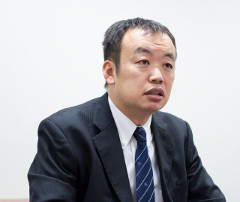The effectiveness of insurance concerning small and medium-sized enterprises has not been studied much

For the reconstruction from the Great East Japan Earthquake, research from all areas including natural sciences, humanities and social sciences is required. In the field of economics and commerce in which I specialize, the reconstruction size and speed of economic activities after the earthquake has become one of the most important research themes. Under such circumstances, I think insurance plays a significant role. Insurance cannot retrieve the lives lost or heal the hearts broken but can partly recover or newly create what has been lost by natural disasters. As such, insurance is expected to play a major role in the reconstruction.
At the time of the Great East Japan Earthquake, insurance companies responded quickly for individuals; it was widely reported by media that about 1.2 trillion yen of earthquake insurance was paid in about half a year after the earthquake. However, as for insurance for companies, especially for SMEs, how the insurance was paid or how it contributed to their reconstruction was not reported much and thus the actual situation is hard to understand. One of the reasons may be that earthquake insurance for companies differs from that for households and the data for company insurance is not readily available. As a result, much research that has focused on loans from banks including overlapping debt and studies on the position of insurance in SMEs and the role it played at the time of the Great East Japan Earthquake has not progressed. In short, not much is known about the effectiveness of insurance for SMEs on their reconstruction in the event of extremely large disasters such as the Great East Japan Earthquake. However, that would make SMEs too vulnerable in Japan, where natural disasters frequently occur and large disasters such as the Nankai Trough Earthquake are expected in the future. The role SMEs play in Japanese economic activities is significant and it is very important for Japan’s economy that such companies undertake appropriate risk management. In that sense, it is essential to analyze the reconstruction processes of SMEs in the Great East Japan Earthquake to prepare for major natural disasters expected in the future.
Earthquake insurance for companies is a huge burden for small and medium-sized enterprises
When it comes to risk management, many people may think of insurance, and indeed, a lot of people may have already purchased earthquake insurance. As a matter of fact, earthquake insurance for households is operated in a way that generates neither profit nor loss, based on the no loss no profit principle and its premiums are inexpensive compared to the earthquake insurance for companies. However, insurance does not cover all the damage incurred; there are limits on the insurance coverage. In other words, insurance benefits paid for by earthquake insurance are not meant to replace buildings or household goods damaged by an earthquake but to be treated as a fund for life reconstruction. If the amount of payment reaches trillions of yen, the government will pay its large part. In short, earthquake insurance for households has a function as public insurance, which prompts many people to buy the insurance and makes the earthquake insurance an effective means of risk management. On the other hand, there is no government support for earthquake insurance for companies. It is common to make a special arrangement of fire insurance as an earthquake coverage agreement. Being afraid of facing a tremendous amount of insurance payments, some insurance companies might be reluctant to provide earthquake insurance. Indeed, right after the Great East Japan Earthquake, underwriting of new earthquake insurance was partly suspended and according to the survey we conducted, about 30% of SMEs that tried to obtain insurance were actually rejected. Since earthquake insurance for companies is sold as a product of insurance companies, some companies may not be able to purchase it even if they wanted to. In addition, even if a company were able to obtain it with high premiums, its burden, especially for SMEs, would be high.
Measures such as insurance alone are not enough

If companies have earthquake insurance, will their reconstruction (recovery such as in sales) proceed smoothly? Our analysis shows that the reconstruction of companies with earthquake insurance has certainly progressed compared to those without it and the effectiveness of insurance has been recognized without any doubt. However, when looking at the amount of insurance received, it is found that the reconstruction of companies that had received a large amount of insurance has been lagging. Why? It is probably because receiving a huge amount of insurance money means that they got such big damage and thus their reconstruction cannot go smoothly even with the large amount of insurance they receive. Therefore, it can be pointed out that earthquake insurance is only effective in reconstruction when the extent of damage is relatively small. We are still analyzing data and further examination still needs to be done. But assuming that our analysis so far is correct, we can say that although the role of insurance in reconstruction is important, depending solely on insurance as the risk management of big natural disasters is a problem.
There are two main methods of risk management. Insurance is called loss finance or risk finance and as for earthquakes, it is a method to obtain funds to recover losses incurred after earthquakes. In contrast, the method to reduce the frequency and/or the amount of loss incurred and to cut down the expected loss is called loss control or risk control. In terms of earthquakes, the frequency of earthquakes cannot be controlled. Therefore, it means actions to reduce the expected amount of loss. One example is seismic reinforcement of factories or office buildings. Loss control and loss finance are both types of risk management conducted by predicting future damage and naturally require costs. In the case of SMEs, there are not many companies that have enough financial margin. When we consider which one is cost-effective risk management based on our analysis, we can say that if significant quake damage is expected, loss control seems to be more effective in the beginning.
Policies to support risk management are also necessary
Although the size of each company is small, SMEs account for more than 99% of all companies and their employees also account for about 70% of all employees in Japan. The roles that SMEs play are significant, especially in the local economy. In the manufacturing industry, most of the companies produce intermediate goods such as parts and trade them with other companies. If one company goes bankrupt, it will affect surrounding companies and, in the end, the local economy as well. There are market principles in which companies that cannot manage risk will be driven out of business. In reality, it has become clear, as a result of the Great East Japan Earthquake, companies which had been poorly managed before the earthquake tend to go out of business. On the other hand, considering the impact on society, the national or local governments can think of particularly supporting or favoring SMEs which promote preventive measures against earthquakes. It is to create a system to encourage SMEs, which are seriously thinking about their own business survival and which serve as the core of the local community, to voluntarily prepare for major earthquakes or natural disasters.
At the same time, SMEs should not consider risk management as a mere cost which does not generate profits. Obtaining insurance or conducting seismic reinforcement can ensure stable supply of products even in the event of disasters. SMEs can use this aspect as their selling point or sales promotion. I think securing business continuity through risk management not only contributes to their own business survival but also enhances the trust of their business partners and contributes to the local economy.
* The information contained herein is current as of June 2018.
* The contents of articles on Meiji.net are based on the personal ideas and opinions of the author and do not indicate the official opinion of Meiji University.
Information noted in the articles and videos, such as positions and affiliations, are current at the time of production.


